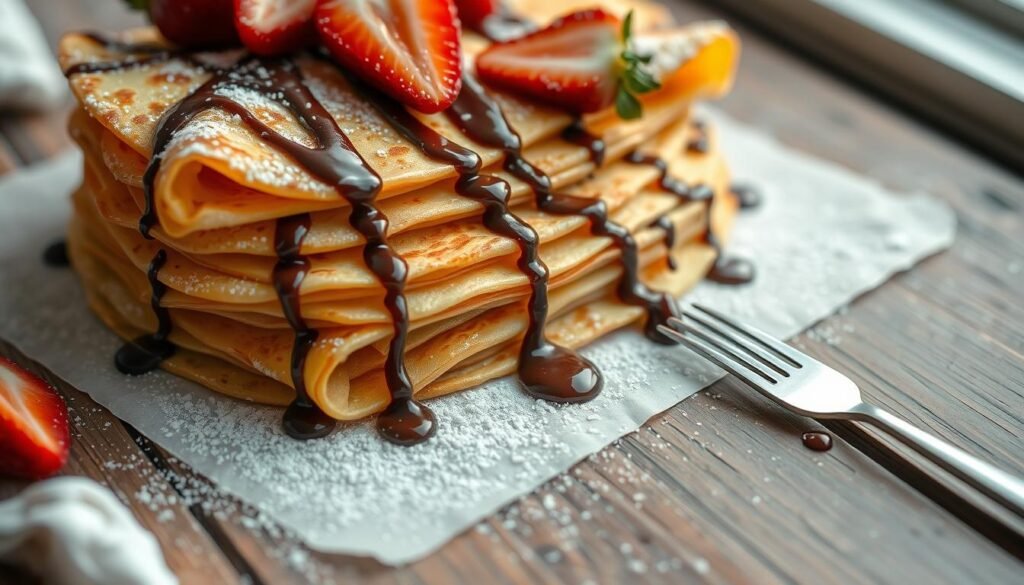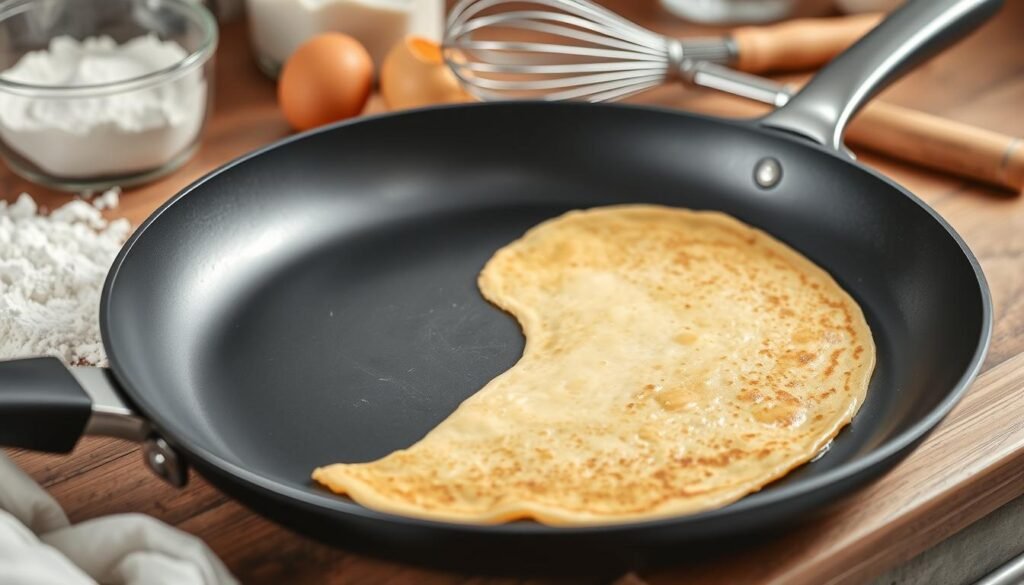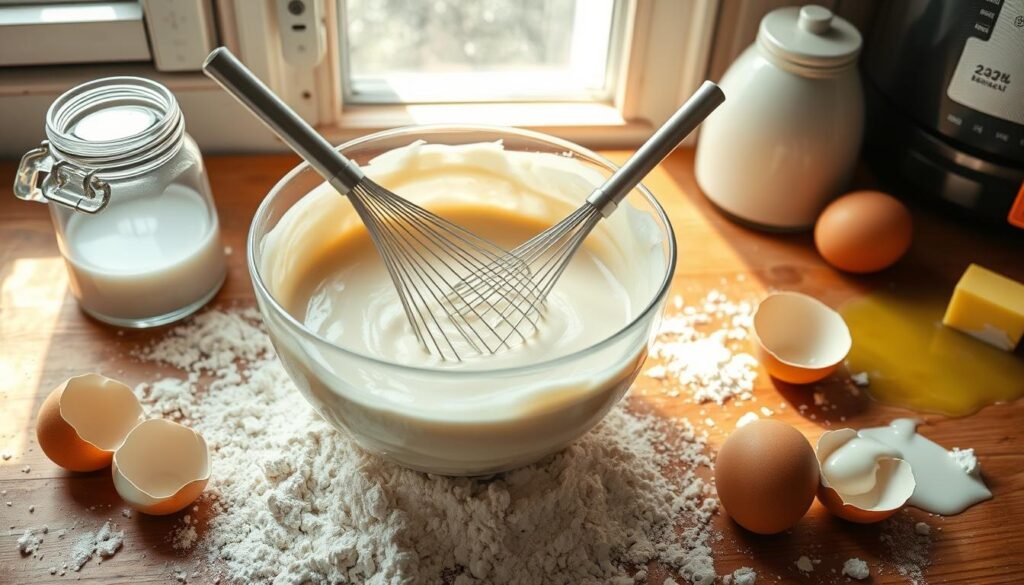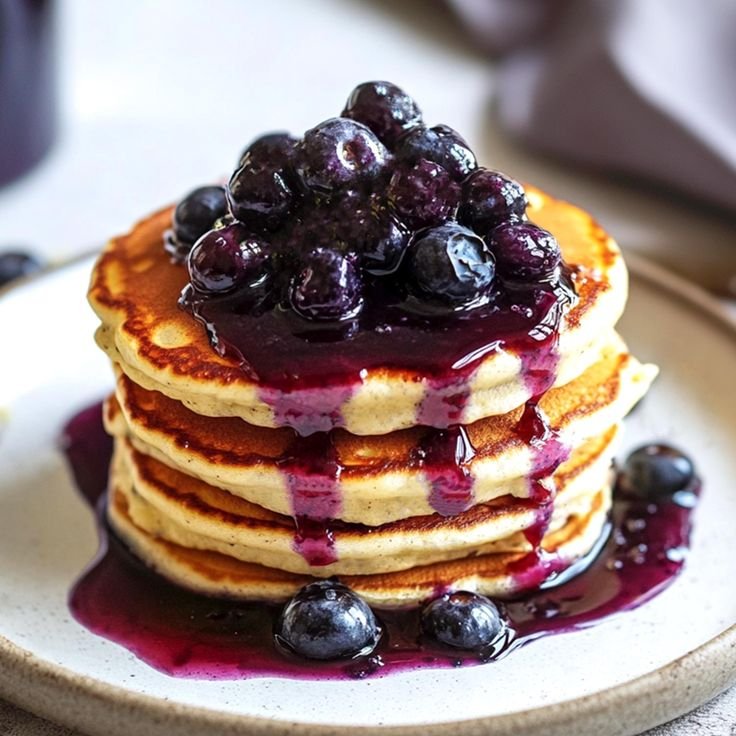The Best Fluffy Pancakes recipe you will fall in love with. Full of tips and tricks to help you make the best pancakes.
Perfect French Crepes : A Simple Guide
Learn to make delicious French crepes in your kitchen. These thin pancakes are a favorite in French cooking. They’re great for breakfast, dessert, or lunch.
This guide will show you how to make perfect French crepes. You’ll learn about ingredients and cooking techniques. Soon, you’ll be making French crepes that are as good as those in Paris.

Key Takeaways
- Discover the secrets to crafting authentic French crepes at home
- Learn about the essential ingredients and equipment needed for perfect homemade crepes
- Master the art of mixing the batter and achieving the right consistency for a crepe recipe
- Explore techniques for cooking and flipping delicate thin pancakes to perfection
- Unlock a world of flavor possibilities by adding your own unique twists
Essential Ingredients
You need to pick the right ingredients. The type of flour and the liquids are key. Each one affects the crepe’s texture and taste.
All-Purpose Flour vs. Special Crepe Flour
While all-purpose flour works, many chefs choose crepe flour. Crepe flour, like buckwheat or wheat and buckwheat mix, makes crepes tender and light. It has less gluten, so crepes are thin and delicate.
Choosing the Right Liquid Components
The liquids in crepe batter are as important as the flour. Milk adds richness and sweetness. But, some recipes mix milk with water or use eggs or butter for a richer taste.
Optional Flavor Enhancers
- Vanilla extract: Adds a warm, fragrant note to the crepes.
- Sugar: A small amount of sugar can help balance the flavors and enhance the caramelization process.
- Citrus zest: Lemon or orange zest can provide a bright, refreshing accent.
Choosing the right crepe ingredients lets bakers make crepes that look great and taste authentic French.
Required Kitchen Tools and Equipment
You need the right tools and equipment. You’ll need a perfect crepe pan and a reliable non-stick skillet. The right utensils are key to success.
Here are the essential items :
- Crepe Pan: A traditional crepe pan is crucial. It’s made of cast-iron or heavy-duty nonstick material. These pans have a shallow, wide surface for even heat and easy flipping.
- Non-Stick Skillet: If you don’t have a crepe pan, a good non-stick skillet works well. Choose a pan with a smooth surface to prevent sticking and make crepe removal easy.
- Crepe Spreader: A crepe spreader, made of wood or silicone, is very helpful. It spreads the batter evenly, making sure your crepes are thin and consistent.
- Spatula for Crepes: A thin, flexible spatula for crepes is vital. It helps you lift and flip crepes gently without tearing or damaging them.
| Tool | Purpose | Recommended Features |
|---|---|---|
| Crepe Pan | Evenly heats and cooks crepes | Cast-iron or heavy-duty nonstick material, shallow and wide surface |
| Non-Stick Skillet | Alternative to a dedicated crepe pan | Smooth, even surface to prevent sticking |
| Crepe Spreader | Distributes batter evenly | Made of wood or silicone for smooth, even spreading |
| Spatula for Crepes | Lifts and flips crepes without tearing | Thin, flexible design for gentle handling |
With these tools, you’ll be on your way to making perfect French crepes. Quality equipment leads to thin, delicate crepes every time.

Basic French Crepe Batter Preparation
Making the perfect crepe batter is key to delicious breakfast. It’s all about the right mixing techniques and letting the batter rest. Let’s explore how to get your batter just right.
Mixing Techniques for Smooth Batter
To get a smooth crepe batter, follow these steps:
- Begin by sifting flour and salt into a big bowl.
- Slowly add milk and eggs while whisking to avoid lumps.
- Blend the batter with a hand mixer or immersion blender until it’s silky and smooth.
Resting Time and Temperature
Letting the batter rest is vital for the right texture. After mixing, cover it and chill in the fridge for 30 minutes to 24 hours. This lets the flour hydrate, making the crepes tender and flexible.
Troubleshooting Common Batter Issues
Having trouble with your batter? Try these fixes:
- If it’s too thick, add a bit more milk until it’s right.
- For a thinner batter, add an extra egg or two.
- Blend it again if it’s lumpy to smooth it out.
Mastering crepe batter prep means you’ll make it every time.

Mastering the Art of Cooking
Making the perfect crepe is an art that needs precision and practice. The secret to great crepes is keeping the right temperature, spreading the batter right, and flipping at the right time. Whether you’re making sweet or savory crepes, mastering these skills will make your cooking experience wonderful.
First, heat your cooking surface to the perfect temperature, between 375°F and 400°F. This heat helps the batter cook fast, making the crepe thin and delicate. When the surface is hot, pour the batter in the middle and spread it out in a circle. This makes sure the crepe is even and has the right thickness.
Flipping the crepe at the right time is key for the perfect crepe thickness and crepe texture. The crepe is ready to flip when the edges start to brown and the center is dry. A quick, confident flip seals in the moisture and makes the crepe look beautiful. With practice, you’ll get better at flipping crepes smoothly, making every crepe look perfect.
Nutritional Benefits
A delicate French favorite, offer several nutritional benefits depending on the ingredients used:
- Low in Calories
Traditional crepes are relatively low in calories, especially when compared to thicker pancakes. With a basic batter (flour, milk, and eggs), crepes can be a lighter option for breakfast or dessert. - Rich in Protein
Made with eggs provide a good source of protein, which supports muscle building, tissue repair, and overall body function. Adding fillings like yogurt, cheese, or ham can further boost the protein content. - Customizable for Nutritional Needs
It can be adapted for different diets, whether by using whole wheat or oat flour for added fiber, or incorporating healthy fats like avocado as a filling. These tweaks can increase their nutritional profile. - Versatile with Toppings
By adding fresh fruits, yogurt, or a drizzle of honey, it can become a rich source of vitamins, antioxidants, and fiber. Savory fillings like spinach, mushrooms, or turkey can make them a balanced, savory meal option. - Good Source of Calcium
When made with milk or fortified plant-based alternatives, crepes provide calcium, which is essential for bone health.
For the healthiest crepes, try pairing them with nutrient-dense fillings or toppings. A simple crepe can easily transform into a balanced, flavorful meal!







